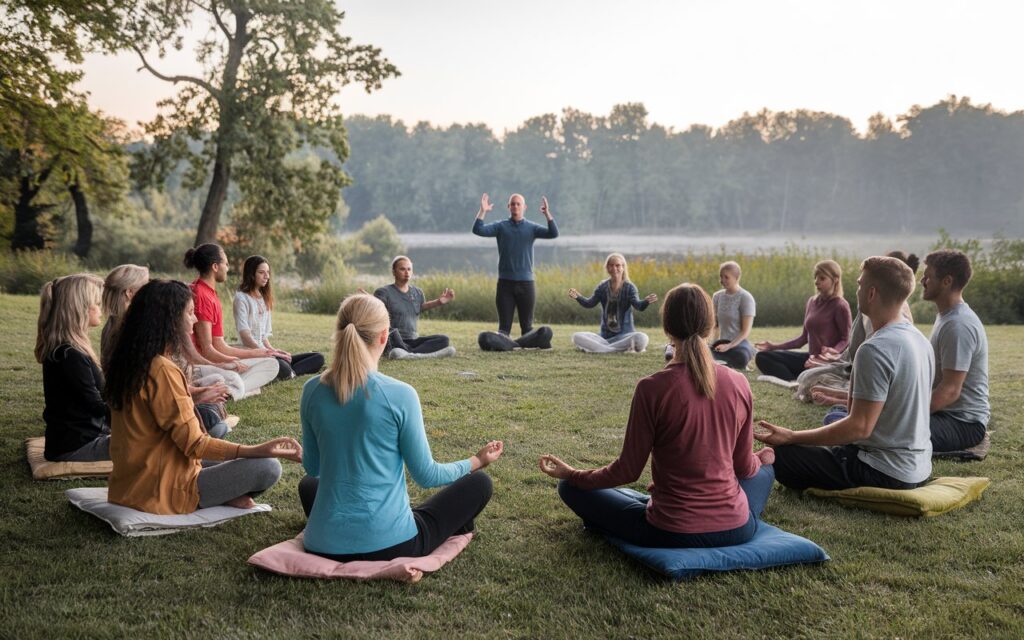Mindfulness Exercises That Will Transform Your Mental Clarity
Looking to find inner peace in a chaotic world? Discover these science-backed mindfulness exercises that can dramatically improve your mental clarity and emotional well-being in just minutes a day. Whether you’re new to mindfulness or looking to deepen your practice, these techniques offer something for everyone.
Introduction
In our fast-paced world, finding mental clarity can feel like searching for a quiet corner in a crowded stadium. Whether you’re juggling work deadlines, family responsibilities, or simply trying to navigate daily life, mental fog can leave you feeling overwhelmed and disconnected. That’s where mindfulness comes in—your practical toolkit for achieving a clearer, calmer mind. By incorporating mindfulness into your daily routine, you can take control of your mental state and create a lasting sense of well-being.
Mindfulness is not just a buzzword; it’s a scientifically backed practice that helps bring awareness to the present moment. By training your mind to focus on the here and now, you can reduce stress, improve concentration, and build emotional resilience. This guide will introduce you to 15 powerful mindfulness exercises designed to help you achieve greater mental clarity and emotional balance.
Why Mindfulness Matters Now More Than Ever
Recent studies reveal that 77% of adults experience regular stress that hampers their mental clarity. Even more striking, researchers at Harvard found that people spend 47% of their waking hours thinking about something other than what they’re doing. This constant mental wandering increases anxiety and reduces productivity. In a world filled with distractions, practicing mindfulness is more important than ever to help us stay grounded and focused.
Mindfulness can be especially beneficial in today’s digital age, where the constant influx of information can leave us feeling scattered and disconnected. It helps us break free from autopilot mode and engage fully with the present moment, enhancing both our mental and emotional well-being. Whether you’re looking to boost productivity, reduce stress, or simply enjoy life more fully, mindfulness offers a practical solution.
15 Game-Changing Mindfulness Exercises for Mental Clarity
For more guidance on building an effective mindfulness practice, explore our home workout routine for beginners to support your physical well-being alongside mental clarity.
To further enhance your mindfulness journey, explore specific practices designed to boost your mental clarity. These exercises can help you manage stress, improve focus, and cultivate a sense of inner peace.
1. The 5-4-3-2-1 Grounding Technique
This powerful exercise engages all your senses to bring you back to the present moment:
- Identify 5 things you can see around you—notice colors, shapes, and details.
- Notice 4 things you can touch—focus on the textures, temperature, and sensations.
- Acknowledge 3 things you can hear—listen to ambient sounds, both near and far.
- Recognize 2 things you can smell—try to identify scents around you, even subtle ones.
- Focus on 1 thing you can taste—whether it’s your coffee, gum, or simply the air in your mouth.
This exercise is particularly useful for calming anxiety and anchoring yourself during stressful moments. It only takes a few minutes but can make a significant difference in how grounded you feel.
2. Mindful Walking (A Moving Meditation)

Transform your daily walk into a moving meditation by:
- Focusing on each step—feel the connection between your feet and the ground.
- Noticing how your feet feel with each movement—pay attention to sensations like pressure and balance.
- Observing your surroundings without judgment—notice the sights, sounds, and smells around you.
- Maintaining steady, relaxed breathing—sync your breath with your steps for added relaxation.
Mindful walking can turn an ordinary activity into a rich experience, helping you stay present and connected with your body and environment. It’s a great way to clear your mind while getting some gentle exercise.
3. Body Scan Meditation (Reconnect with Your Body)
To complement your meditation practice, consider our home workouts guide for physical exercises that align with mindfulness.
Perfect for reducing tension and easing mental stress:
- Lie down comfortably—use a mat or lie on your bed.
- Focus on each body part, from toes to head—bring your awareness to each part of your body in sequence.
- Release tension systematically—imagine each part relaxing as you focus on it.
- Spend 10-20 minutes practicing—take your time to scan your entire body, noticing areas of tension and allowing them to soften.
Body scan meditation is a wonderful way to connect with your physical self and release pent-up stress. It can be especially helpful before bedtime, promoting a restful night’s sleep.
4. Mindful Breathing (Breathe Your Way to Clarity)

A cornerstone of mental clarity:
- Find a quiet space—sit or lie down in a comfortable position.
- Focus on your natural breath—observe each inhale and exhale without trying to change it.
- Count your breaths if helpful—count to four on each inhale and exhale to help maintain focus.
- Start with 5 minutes daily—increase the duration gradually as you become more comfortable.
Mindful breathing is one of the simplest yet most effective mindfulness techniques. It can be done anywhere, anytime, and is a powerful way to calm the mind and center yourself.
5. Loving-Kindness Meditation (Cultivate Compassion)

Building emotional resilience also benefits from good nutrition. Learn more about immunity-boosting superfoods that can enhance your mental well-being.
Build emotional resilience by:
- Directing positive thoughts to yourself—repeat phrases like, “May I be happy, may I be healthy.”
- Extending warmth to loved ones—send loving wishes to family and friends.
- Including neutral people and challenging relationships—extend the same positive thoughts to those you may not feel strongly about, and even to those you find challenging.
- Visualizing positive energy surrounding each person—this helps create a sense of connection and compassion.
Loving-kindness meditation is a powerful way to cultivate empathy and reduce negative emotions. It can help you feel more connected to others and improve your emotional well-being.
6. Box Breathing (Square Breathing for Calmness)
Used by Navy SEALs for focus and relaxation:
- Inhale for 4 counts—breathe in slowly and deeply.
- Hold for 4 counts—pause and feel the fullness of your breath.
- Exhale for 4 counts—release the breath evenly.
- Hold for 4 counts—pause before the next inhale.
Repeat this cycle for several minutes. Box breathing is a highly effective way to reduce anxiety and bring your mind to a state of calm focus, making it an excellent tool for high-stress situations.
7. Mindful Eating (Savor Every Bite)
Turn meals into moments of mindfulness:
- Observe the appearance, texture, and flavor of each bite—take a moment to appreciate your food visually before eating.
- Eat slowly and savor each bite—put your utensils down between bites to slow down the process.
- Express gratitude for your food—acknowledge the effort that went into growing, preparing, and cooking your meal.
- Notice how your body feels—tune in to feelings of hunger, fullness, and satisfaction.
Mindful eating helps you develop a healthier relationship with food, promotes better digestion, and enhances your enjoyment of meals. It encourages you to appreciate each bite and avoid overeating.
8. Sound Awareness (Listen to the Present)
Sound awareness can be particularly effective in combination with a positive mindset. Discover more about boosting mental wellness.
Develop present-moment awareness:
- Listen to surrounding sounds—whether it’s birds chirping, the hum of an air conditioner, or distant traffic.
- Notice both distant and nearby sounds—try to distinguish between sounds close to you and those far away.
- Avoid labeling or judging—don’t try to identify or categorize the sounds; simply listen.
- Stay curious about each sound—observe how sounds change and evolve over time.
Sound awareness can help you feel more grounded and present. It’s a great exercise to do when you’re feeling overwhelmed and need to bring your focus back to the moment.
9. Visualization (Create Your Mental Sanctuary)

Create a mental sanctuary:
- Imagine a peaceful place—visualize a setting that brings you comfort, such as a beach, forest, or garden.
- Engage all senses—imagine the sights, sounds, textures, and even smells of this place.
- Practice regularly for mental relaxation—visit this place in your mind whenever you need to de-stress.
- Use positive imagery—visualize yourself feeling calm, happy, and at peace.
Visualization can be a powerful tool for reducing anxiety and boosting mood. It helps create a mental “safe space” that you can retreat to whenever you need a break from stress.
10. Mindful Movement (Integrate Awareness with Action)
For a complete approach to staying active, check out our home workouts guide for exercises that blend well with mindful movement.
Combine awareness with physical activity:
- Practice gentle yoga or tai chi—focus on the flow of movement and how your body feels.
- Try mindful stretching—stretch slowly and pay attention to each movement, noticing sensations of tension and release.
- Focus on how your body feels during each movement—notice your muscles, joints, and the rhythm of your breath.
- Incorporate mindfulness into everyday activities—turn activities like cleaning or gardening into a mindful practice by staying present.
Mindful movement is a great way to integrate mindfulness into physical exercise, making workouts more enjoyable and meditative.
11. Thought Labeling (Observe and Let Go)
Manage racing thoughts by:
- Observing without attachment—watch your thoughts as if they’re clouds passing in the sky.
- Labeling thoughts (e.g., planning, worrying, remembering)—give each thought a label to create distance from it.
- Letting them pass naturally—avoid engaging with or trying to change the thoughts; simply observe and let them drift away.
- Returning to your breath—use your breath as an anchor to bring yourself back to the present.
Thought labeling helps you recognize thought patterns without getting caught up in them. It’s an effective way to break cycles of worry and overthinking.
12. RAIN Technique (Process Emotions with Compassion)
A powerful way to process difficult emotions:
- Recognize what’s happening—acknowledge the emotion or thought that’s present.
- Allow it to be there—give yourself permission to feel without trying to change or suppress it.
- Investigate with kindness—explore where the emotion is coming from, without self-judgment.
- Rest in Natural awareness—allow yourself to simply be, without needing to fix or analyze.
The RAIN technique is a compassionate approach to dealing with challenging emotions. It encourages self-awareness and acceptance, which can lead to profound emotional healing.
13. Color Walking (Enhance Visual Awareness)
Enhance your visual awareness:
- Choose one color to focus on during a walk—decide on a color before you start your walk.
- Notice that color everywhere you go—observe it in nature, signs, buildings, and clothing.
- Stay present with observations—use the color as an anchor to keep your attention in the moment.
- Switch colors to keep the practice fresh—each time you go for a walk, choose a new color to focus on.
Color walking is a simple yet effective way to bring mindfulness into a mundane activity. It helps sharpen your focus and appreciation for the world around you.
14. Mindful Technology Use (Digital Mindfulness)
Cultivate digital mindfulness by:
- Setting boundaries on screen time—decide on specific times for using devices and stick to them.
- Taking regular breaks from devices—step away from screens to reconnect with your surroundings.
- Practicing conscious scrolling—before using social media, set an intention, and be mindful of how long you spend online.
- Monitoring screen time—use apps to track your usage and identify habits that may be affecting your well-being.
Mindful technology use helps you maintain control over your digital life, reducing stress and improving your focus. It encourages a healthier relationship with devices and prevents tech burnout.
15. Gratitude Practice (Shift to a Positive Mindset)

To keep yourself motivated, explore our guide on staying motivated to achieve long-term goals.
Develop a positive mindset through:
- Keeping a gratitude journal—write down three things you’re grateful for each day.
- Expressing appreciation daily—tell someone you appreciate them, either in person or through a message.
- Noticing small pleasures in your life—become aware of simple joys, like a warm cup of tea or a beautiful sunset.
- Sharing thankfulness with others—share your gratitude with friends and family to spread positivity.
Gratitude practice is a powerful way to shift your focus from what’s lacking to what’s abundant in your life. It can significantly improve your overall happiness and satisfaction.
Common Questions About Mindfulness Exercises
Here are some frequently asked questions to help you get the most out of your mindfulness exercises.
How Long Should I Practice?
Start with 5-10 minutes daily. Research shows consistency matters more than duration—even brief sessions can improve focus by 14% after eight weeks of regular practice. As you get comfortable, gradually extend your sessions to 20 or 30 minutes. The key is to make mindfulness a regular part of your routine.
When’s the Best Time to Practice?
Mindfulness Exercises sets a positive tone for the day, but any consistent time works. Studies indicate that practicing at the same time daily helps build lasting habits. Some people prefer practicing in the evening to wind down, while others find midday sessions helpful for resetting their focus. Experiment to find what works best for you.
What If I Can’t Stop Thinking?
That’s normal! Mindfulness isn’t about stopping thoughts—it’s about observing them without attachment. Research found that experienced meditators have the same number of thoughts as beginners, but they are less disturbed by them. Instead of trying to eliminate thoughts, acknowledge them, and gently return your focus to your breath or chosen point of awareness.
The Science Behind Mental Clarity
Mindfulness is more than a feel-good practice—it’s backed by science. Here are some of the key findings that demonstrate the power of mindfulness in enhancing mental clarity.
Research published in the Journal of Consulting and Clinical Psychology shows that regular mindfulness practice can:
- Reduce anxiety by 58%
- Improve focus by 31%
- Enhance memory retention by 27%
- Boost creative problem-solving by 22%
- Lower levels of cortisol, the stress hormone, which helps improve overall health
- Increase gray matter density in the brain areas responsible for learning, memory, and emotion regulation
These findings highlight the significant impact mindfulness can have on both mental and physical well-being. By practicing regularly, you can harness these benefits to create a more balanced and focused life.
Tips for Success
If you’re looking for ways to maintain motivation during your mindfulness Exercises, read our tips on how to motivate yourself to achieve your goals.
To make the most of your mindfulness journey, consider these practical tips that can help you stay consistent and motivated.
- Start small and build gradually—begin with just a few minutes a day and work your way up.
- Create a dedicated practice space—having a designated area can help create a sense of ritual and focus.
- Use guided recordings to begin—many apps and online resources offer guided meditations to help you get started.
- Join a mindfulness community for support—connecting with others can provide motivation and accountability.
- Track your progress and celebrate small wins—use a journal to note your experiences and acknowledge your growth.
- Be patient with yourself—mindfulness is a practice, and it’s okay if your mind wanders. The important thing is to keep coming back.
Conclusion
Mindfulness is a lifelong journey, not a destination. By incorporating these Mindfulness Exercises into your daily routine, you’ll be taking important steps towards mental clarity, emotional well-being, and a more centered life.
Incorporating these mindfulness exercises into your daily routine can help you transform your relationship with your mind, leading to a more peaceful and focused life. Start with just one exercise that resonates with you, and gradually expand your practice over time. Remember, every moment of mindfulness is a step toward lasting mental clarity and well-being. Whether it’s a few mindful breaths during a hectic day or a longer meditation session, each practice brings you closer to a calmer, more centered version of yourself. With consistent practice, you can cultivate a mind that is not only clearer but also more resilient and joyful.





4 Comments